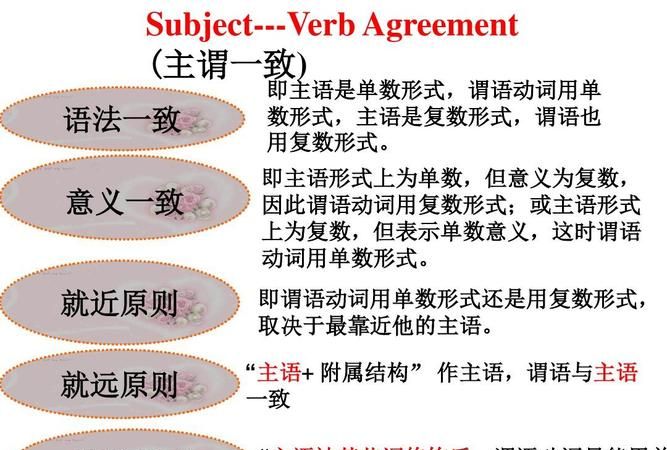本文目录
amountsof作主语的谓语单复数?
展开1全部
amounts of...意思是“许多/大量的...”,不过它一般修饰不可数名词,所以如果该短语做句子主语,根据就近原则,谓语动词还是使用单数形式。
如:(Large) Amouts of dirty water was poured into the river.
不过现在的语法比较灵活,有的说amounts of后面修饰可数名词复数也可以,所以的确不好准确判断。
楼主知道其做主语时,谓语动词的数和其后名词的性质和数保持一致即可。

a large amount of修饰可数名词还是不可数名词
展开1全部
是的,a large amount of只能修饰不可数名词。
顺便总结一下l:
只能修饰可数名词的:a large/ great/ good number of,a good/ great many,dozens of,scores of,quite a few
只能修饰不可数名词的:a great deal of,a large amount of,quite a little,a large sum of
既可修饰可数也可修饰不可数名词的:plenty of,a lot of,lots of,a large quantity of,a good supply of
希望能够帮到你,祝你进步,好好学习,天天向上哦,加油!

英语主谓一致语法讲解
展开3全部
主谓一致即谓语动词在人称和数上要和主语保持一致,主谓一致包括语法一致、意义一致和就近一致,语法一致即谓语动词在单复数形式上要和主语保持一致,意义一致就是谓语动词要和主语意义上的单复数保持一致,就近一致就是谓语动词要和靠近它的主语部分保持一致。
主谓一致( Subject-Verb Concord )
就其在现代语法中的基本原则而言,通常有三个不同角度的着眼点:1,语法一致 2,意义一致 3,就近原则。
(1)语法一致
主谓一致的原则是指,主语和谓语从语法形式上取得一致:
主语是单数形式,谓语也采取单数形式;主语是复数形式,谓语必须采取复数形式。
例如:
A grammar book helps you learn something about the rules of a language.语法书帮助你学习语言的某些规则。(主语是单数形式,谓语也采取单数形式)
(2)不定式,动名词,以及从句作主语时应看作单数,谓语动词用单数。
例如:
Reading often means learning .读书常意味是学习。
(3)不定代词及each作主语或是修饰主语时应看作单数,谓语动词用单数。
例如:
Neither of my sisters likes sports .我的妹妹中没人喜欢运动。
(4)表示国家,机构,事件,作品等名称的专有名词作主语时应看作单数,谓语动词用单数。
例如:
One Thousand And One Nights tells people lots of mysterious bits of folklore .《一千零一夜》给人们讲了许多神秘的民间传说。
(5)a series of,a kind of,the number of等与名词构成名词短语作主语时看作单数,谓语动词用单数。
例如:
A series of high technology products has been laid out in the exhibition. 一系列高科技产品已在展览上展出。
(6)由some,several,both,few,many,a number of 等词修饰主语,或是由它们自身作主语时应看作复数,谓语动词用复数。
例如:
Both of us are fond of watching football games .我们俩都喜欢看足球赛.
(7)由and连接两个主语时,如指同一人或物,谓语用单数;指不同的人或物,谓语用复数.
On the seashore,some people are playing volleyball and some are lying in the sun. 海边,有些人在打排球,有些人躺着晒太阳.
(8)有些短语,如:a lot of,most of,any of,half of,three fifths of,eighty percent of,some of,none of,the rest of,all of等后接不可数名词,或是单数形式的名词作主语时应看作单数,谓语动词用单数;但如果后接可数名词的复数形式作主语时应看作复数,谓语动词用复数。
例如:
A lot of money in the shop was stolen yesterday when the electricity was suddenly cut off. 昨天突然断电时,那家商店丢失了许多钱.
(9)主语为单数个不定式(短语)、动名词(短语)或从句时,谓语动词一般用单数。
(10)主语为三单,或习惯用作单数名词或不可数名词的词,如:money,information,clothing等,谓语动词用单数。
意义一致(Notional Concord )
这一原则是指,从意义着眼来解决主谓一致问题.有时主语形式上为单数,但意义上却是复数,那么谓语依意义也用复数形式;而有时主语形式上为复数,但意义上却是单数,那么谓语依意义亦用单数形式。
(1)当主语后面接由as well as,as much as,accompanied by,including,in addition to,more than,no less than,rather than,together with等引导的词组时,其谓语动词的形式要依主语的单复数而定。
在这样的句子里,这些词所引导的词组不影响主语自身的单,复数形式,它们在句子里其实是状语.也就是说,我们完全可以将这些词组搬到句首或是放到句末去.从表面上我们也可以看出,它们与主语之间有","隔开。
例如:
Petroleum,along with fuel gas,has recently risen in price.目前石油和燃料煤气的价格上涨了。
(2)表示时间,金钱,距离,体积,重量,面积,数字等词语作主语时,其意义若是指总量应看作单数,谓语动词用单数;但如果其意义是指"有多少数量"则应该看作是复数,那么谓语动词也应该用复数。
例如:
Four weeks are often approximately regarded as one month.人们常大约地将四个星期看成一个月。
(3)形容词前加定冠词即"the + 形容词"作主语时,其意义若是指个人或是抽象概念应看作单数,谓语动词用单数;但如果其意义是指一类人则应该看作是复数,那么谓语动词也应该用复数。
例如:
The young,on the one hand,often think of the old conservative. On the other hand,the old always consider the young inexperience.一方面,青年人常认为老年人保守;另一方面,老年人总是认为青年人没有经验。
(4)当and连接两个并列主语在意义上指同一人,同一物,同一事或者同一概念时,应看作单数,谓语动词用单数.另外,当and 连接两个形容词去修饰一个单数形式的主语时,其实是指两种不同的事物,主语则应该看作是复数,那么谓语动词也应该用复数。
例如:
War and peace is a constant theme in history. 战争与和平是一个历史上的永恒的主题.
(5)集体名词作主语时,谓语动词的数取决于主语的意义:主语表示整体时视为单数,谓语动词用单数;主语表示集体中的个体成员时视为复数,谓语动词用复数.这类集体名词常见的有:
army,audience,cattle,class,club,committee,crowd,family,government,group,majority,minority,part,people,police,public,staff,team等等,其中cattle,people,police一般看成复数形式.
例如:
The family are all fond of football. 那一家人都喜欢足球.
就近原则(Principle of Proximity )
这一原则是指,谓语动词的人称和数常常与最近作主语的词语保持一致.常出现在这类句子中的连词有:or,either… or …,neither… nor …,not only… but also …等.例如:
Either I or they are responsible for the result of the matter.不是我,就是他们要对那件事的结局负责任。
Neither the unkind words nor the unfriendly attitude has caused me any distress.既不是那些不友好的话,也不是那不友好的态度让我沮丧。

扩展资料
1、并列结构作主语时的主谓一致
由and 连接的两个单数名词作主语时,谓语动词一般根据语法一致的原则用复数。
如:
A young man and a girl want to go there.一个青年男子和一个姑娘想去那里。
2、但如果在意义上指同一个人,同一件事或同一个概念时,谓语动词要用单数形式.如:
A needle and thread was found on the floor.在地板上找到了针线(穿了线的针)。
当each ...and each...,every...and every...,no...and no...,many a...and many a...结构作主语时,谓语动词用单数形式.
如:
No man and no animal is to be found on the moon.在月球上没发现人和动物。
3、一个单数名词同时被两个不同的形容词修饰,表示两个不同的概念时,谓语动词一
般用复数.
如:
Ancient and modern history are the subjects we are studying.古代史和现代史是我们目前学习的课程。
但如果表示的是同一概念时应用单数。
如:
The last and most difficult lesson is lesson14.14课是最后一课也是最难的一课。
4、由not only... but also ...,either...or ...,neither... nor...,... or...连接的并列主语,谓语动词通常依就近一致原则决定.
如:
Either the players or the coach is responsible for the defeat.不是运动员就是教练应该对这次比赛的失利负责。
5、当主语由as well as,along with,together with,ratherthan,no less than,but,except,besides,in additionto,like,including等词连接时,其谓语动词的单复数形式通常由前面的词来决定。
如:
An iron and steal works,with some satellite factories. is to be built here.在这里将建立一个钢铁厂和一些卫星厂。
参考资料来源:百度百科-主谓一致
an amount of和amounts of的区别
展开3全部
an amount of 与 amounts of 的区别为:谓语动词不同、意思不同、用法不同。
一、谓语动词不同
1、an amount of :an amount of 的谓语动词用复数。
2、amounts of:amounts of的谓语动词用单数。
二、意思不同
1、an amount of :an amount of 的意思为数量;总量。
2、amounts of:amounts of的意思为大量的。

三、用法不同
1、an amount of:Initiate a transfer by selecting an amount of funds and the destination of the transfer. 通过选择资金金额和转帐目的地来启动转帐。
2、amounts of:Laser discs can store prodigious amounts of information. 激光磁盘能够贮存大量信息。
以上就是关于主谓一致amount ,amountsof作主语的谓语单复数?的全部内容,以及主谓一致amount 的相关内容,希望能够帮到您。
